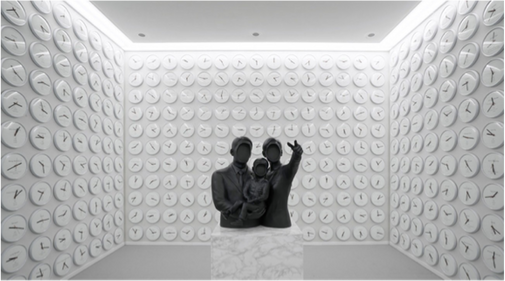top of page
The 57th Venice Biennale Korean Pavilion
Venice, Italy
2017
Hzone : Artistic Direction, Planning & Management, Artist Selection, Curators Interview, PR & Marketing, International Networking, Exhibition Design, Donation Program, Catalog Publications
Client : Arts Council Korea
Artists : Cody Choi, Lee Wan
Counterbalance: The Stone and the Mountain was the exhibition at the Korean Pavilion of the 2017 Venice Biennale, curated by Artistic Director Lee Daehyung.
The subtitle, "The Stone and the Mountain," reflects how two things that are fundamentally the same can be perceived as entirely different depending on their scale. Throughout history, we have witnessed the collapse of balance in various relationships—between individuals and collectives, Korea and Asia, Asia and the world. The exhibition critically examines Korea’s modern history and expands this perspective to address broader Asian and global issues. By highlighting the failure of majorities to listen to minorities and the isolationist policies of powerful nations rejecting immigrants from weaker countries, the exhibition paradoxically exposes the violence of the 21st century, where consideration for humanity has been lost. The aim is to restore balance (Counterbalance) through artistic discourse.
The exhibition explored the complex interrelations among three generations of artists: Mr. K—Cody Choi—Iwan, addressing themes of Korean identity and its politics within a global context. Cody Choi presented ten works, including the neon installation "Venetian Rhapsody," reminiscent of a Las Vegas casino. Lee Wan showcased six works, including the new pieces "Proper Time" and "Mr. K and the Collection of Korean History."
The 2017 Venice Biennale Korean Pavilion exhibition examined the trajectory of modern Korean history and identity through three generations—Mr. K, Cody Choi, and Lee Wan. It explored the shifting identity of Koreans between individual and collective, Korea and the world, tradition and modernity, emphasizing intergenerational connections.
Mr. K originated from a box discovered in an antique shop in Cheonghak-dong, Korea, containing the life records of an unknown Korean man. The box held photographs documenting his life from birth, through war, to his final days. Who was this man, and what kind of life did he lead? He was not merely an individual but a reflection of Korea’s transformation through war, modernization, and globalization.
The Korean Pavilion embodied a new direction in contemporary Korean art, reflecting on identity within the intricate interplay of personal narratives and historical structures. The journey that began with Mr. K ultimately explored how individual experiences are interwoven into collective memory within the broader context of Korea’s modern history.
Counterbalance: The Stone and the Mountain was more than an exhibition; it embodied a commitment to sustainability and environmental awareness. Just as the exhibition explored the restoration of balance, the Korean Pavilion recognized the environmental challenges facing Venice and sought ways to contribute.
A portion of the exhibition’s proceeds was donated to We Are Here Venice, a nonprofit organization dedicated to preserving the Venetian lagoon and promoting sustainable urban environments. This contribution signified a meaningful connection between the Biennale and its host city, reinforcing the responsibility of international art events to consider their ecological impact.
Beyond financial support, this initiative underscored the need for environmental consciousness within global art exhibitions. At a time when the Biennale was generating significant waste, the Korean Pavilion’s action served as an example of how art can take on social responsibility.
The 2017 Korean Pavilion played a key role in fostering a broader awareness of sustainability within the Biennale, encouraging other national pavilions to reflect on their environmental impact and take steps toward responsible exhibition practices.
Lee Wan’s Proper Time, exhibited at the 2017 Venice Biennale Korean Pavilion, was a striking installation composed of 667 clocks, each moving at a different speed. Every clock represented an individual, with its pace determined by the time that person must work to afford a single meal. The data was derived from labor statistics across 193 countries.
Proper Time highlighted global economic disparities and questioned the standardized, universal concept of time. By presenting time as a variable shaped by socioeconomic conditions, Lee Wan encouraged viewers to reflect on the complexities of the modern world and the value society assigns to time.
Cody Choi’s Venetian Rhapsody is known for its witty interpretation of casino capitalism and the broader complexities of global capitalism.
His work draws a clever parallel between the frenzy and chaos of the Venice Biennale and the unpredictable, volatile nature of the global financial system.
This critical perspective is both insightful and engaging, solidifying his position as a significant voice in contemporary art.
bottom of page































